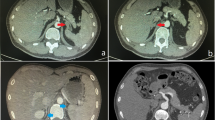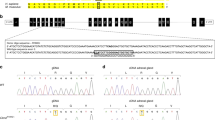Abstract
In glucocorticoid-remediable aldosteronism (GRA), there is a large interfamily variation of phenotype. We report three subjects with GRA in a single family (parents, two brothers and two sisters), of whom only one (proband) displayed classical features of the mineralocorticoid excess. The proband was a man found to be hypertensive and hypokalaemic at the age of 24 years. Plasma renin activity was suppressed and plasma aldosterone was repeatedly elevated. Blood pressure and aldosterone levels normalized within 5 days of dexamethasone therapy. The presence of a chimaeric CYP11B1/CYP11B2 gene was demonstrated by long-PCR and Southern blotting (crossover site at the end of intron 3) in the proband, in the younger sister (sibling 1) and in the father. In these patients, sequencing of the chimaeric portion of CYP11B1 did not reveal any mutation, while sequencing of the chimaeric portion of CYP11B2 showed a V386A polymorphism in exon 7, known to cause only a minimal impairment of enzymatic activity. Sibling 1 was normotensive, normokalaemic and had normal PRA and aldosterone. The father had normal blood pressure and potassium, low-normal PRA and normal aldosterone. All three subjects had elevated levels of urinary 18-hydroxycortisol and 18-oxocortisol. Baseline 11-deoxycorticosterone (DOC), corticosterone (B) and aldosterone were high in the proband and normal in the father and sibling 1; 11-deoxycortisol (S) and cortisol (F) were normal. ACTH induced a normal increase of B, DOC, S and F, and an excessive aldosterone increase in all three patients. Abnormalities in the chimaeric portions of CYB11B1 or CYP11B2 genes did not account for the phenotypic disparity of the different members in a single GRA family. Altered regulation of the chimaeric gene may be responsible for differences in its activity.
This is a preview of subscription content, access via your institution
Access options
Subscribe to this journal
Receive 12 digital issues and online access to articles
$119.00 per year
only $9.92 per issue
Buy this article
- Purchase on Springer Link
- Instant access to full article PDF
Prices may be subject to local taxes which are calculated during checkout
Similar content being viewed by others
References
Sutherland DJA, Ruse JL, Laidlaw JC . Hypertension, increased aldosterone secretion and low plasma renin activity relieved by dexamethasone. Can Med Assoc J 1966; 95: 1109–1119.
Dluhy RG, Lifton RF . Glucocorticoid-remediable aldosteronism. J Clin Endocrinol Metab 1999; 84: 4341–4344.
Stowasser M, Gordon RD . Primary aldosteronism: learning from the study of familial varieties. J Hypertens 2000; 18: 1165–1176.
Lifton RB et al. A chimaeric 11β-hydroxylase/aldosterone synthase gene causes glucocorticoid remediable aldosteronism and human hypertension. Nature 1992; 35: 262–265.
Mulatero P et al. Diagnosis of glucocorticoid-remediable aldosteronism in primary aldosteronism: aldosterone response to dexamethasone and long polymerase chain reaction for chimeric gene. J Clin Endocrinol Metab 1998; 83: 2573–2575.
Pascoe L, Curnow KM, New MI, Corvol P . The relationship between phenotype and genotype on glucocorticoid-suppressible hyperaldosteronism (GSH). In: New MI (ed). Where Phenotype does not Match Genotype, Ares-Serono Symposia Series—Frontiers in Endocrinology, Vol. 16. Ares-Serono: Rome, 1996, pp 69–79.
Dluhy RG, Lifton RP . Phenotypic variation in glucocorticoid-remediable aldosteronism (GRA). In: New MI (ed). Where phenotype does not Match Genotype, Ares-Serono Symposia Series—Frontiers in Endocrinology, Vol. 16. Ares-Serono: Rome, 1996, pp 81–90.
Fallo F et al. A new family with dexamethasone-suppressible hyperaldosteronism: aldosterone unresponsiveness to angiotensin II. Clin Endocrinol (Oxf) 1985; 22: 777–785.
Rich GM et al. Glucocorticoid-remediable aldosteronism in a large kindred: clinical spectrum and diagnosis using a characteristic biochemical phenotype. Ann Intern Med 1992; 116: 813–820.
Gates LJ et al. Variation of phenotype in patients with glucocorticoid remediable aldosteronism. J Med Genet 1996; 33: 25–28.
Mulatero P et al. Glucocorticoid remediable aldosteronism: low morbidity and mortality in a four-generation italian pedigree. J Clin Endocrinol Metab 2002; 87: 3187–3191.
Boschi S et al. Measurement of steroid hormones in plasma by isocratic high performance liquid chromatography coupled by radioimmunoassay. Clin Chim Acta 1994; 231: 107–113.
Gomez-Sanchez CE, Leon LM, Gomez-Sanchez EP . Biotin-hydrazide derivatives for the development of steroid enzyme-linked immunoassay. J Steroid Biochem Mol Biol 1992; 43: 523–527.
Yamakita N et al. Simultaneous measurement of plasma 18-oxocortisol and 18-hydroxycortisol levels in normal man. Eur J Endocrinol 1994; 131: 74–79.
Mulatero P et al. Recombinant CYP11B genes encode enzymes that can catalyze conversion of 11-deoxycortisol to cortisol, 18-hydroxycortisol, and 18-oxocortisol. J Clin Endocrinol Metab 1998; 83: 3996–4001.
Mulatero P et al. Blood pressure in patients with primary aldosteronism is influenced by bradykinin B2 receptor and α-adducin gene polymorphisms. J Clin Endocrinol Metab 2002; 87: 3337–3343.
Ganguly A, Weinberger MH, Guthrie GP, Fineberg NS . Adrenal steroid response to ACTH in glucocorticoid-suppressible aldosteronism. Hypertension 1984; 6: 563–567.
Jamieson A et al. Altered 11β-hydroxylase activity in glucocorticoid-suppressible hyperaldosteronism. J Clin Endocrinol Metab 1996; 81: 2298–2302.
Fallo F, Kuhnle U, Boscaro Ma, Sonino N . Abnormality of aldosterone and cortisol late pathways in glucocorticoid-remediable aldosteronism. J Clin Endocrinol Metab 1994; 79: 772–774.
Curnow KM et al. The amino acid substitutions Ser288Gly and Val320Ala convert the cortisol producing enzyme, CYP11B1, into an aldosterone producing enzyme. Nat Struct Biol 1997; 1: 32–35.
Pascoe L et al. Mutations in the human CYP11B2 (aldosterone synthase) gene causing corticosterone methyl oxidase II deficiency. Proc Natl Acad Sci 1992; 89: 4996–5000.
Wasniewska M et al. Aldosterone synthase deficiency type 1 with no documented mutations in the CYP11B2 gene. Eur J Endocrinol 2001; 144: 59–62.
Acknowledgements
We thank Professor Celso Gomez-Sanchez (University of Jackson, Mississippi, USA) for the kind gift of the antibodies used in the 18-OHF and 18-oxoF assays. We are also indebted to Dr Leigh Pascoe (CEPH, Paris France) for helpful advice.
Author information
Authors and Affiliations
Corresponding author
Rights and permissions
About this article
Cite this article
Fallo, F., Pilon, C., Williams, T. et al. Coexistence of different phenotypes in a family with glucocorticoid-remediable aldosteronism. J Hum Hypertens 18, 47–51 (2004). https://doi.org/10.1038/sj.jhh.1001636
Received:
Revised:
Accepted:
Published:
Issue Date:
DOI: https://doi.org/10.1038/sj.jhh.1001636
Keywords
This article is cited by
-
Postoperative adrenal insufficiency in Conn’s syndrome—does it occur frequently?
Journal of Human Hypertension (2022)
-
Monogenic forms of low-renin hypertension: clinical and molecular insights
Pediatric Nephrology (2022)
-
Seltene Formen der Hypertonie
Der Internist (2015)
-
Role of KCNJ5 in familial and sporadic primary aldosteronism
Nature Reviews Endocrinology (2013)
-
Differential diagnosis of primary aldosteronism subtypes
Current Hypertension Reports (2009)



